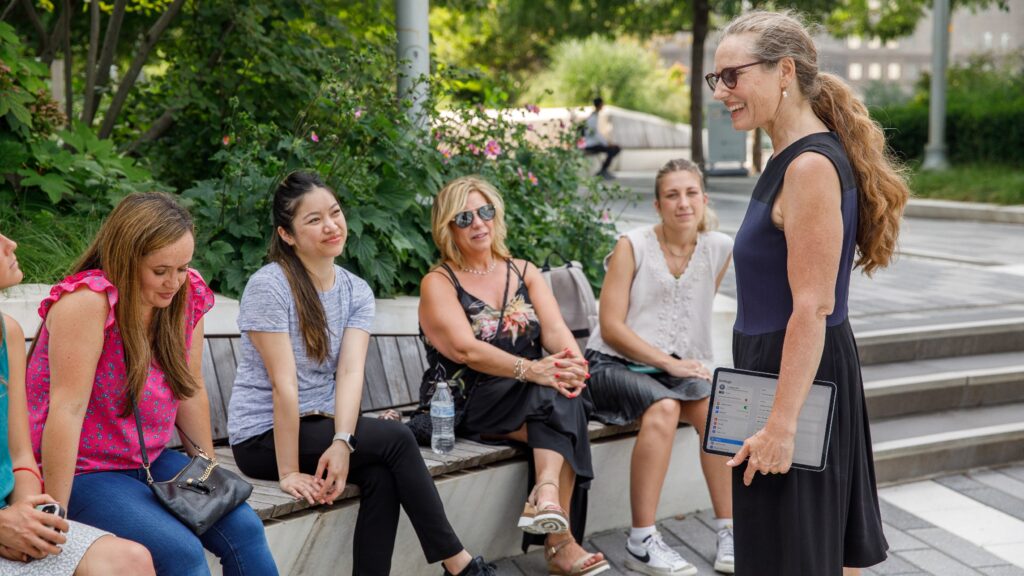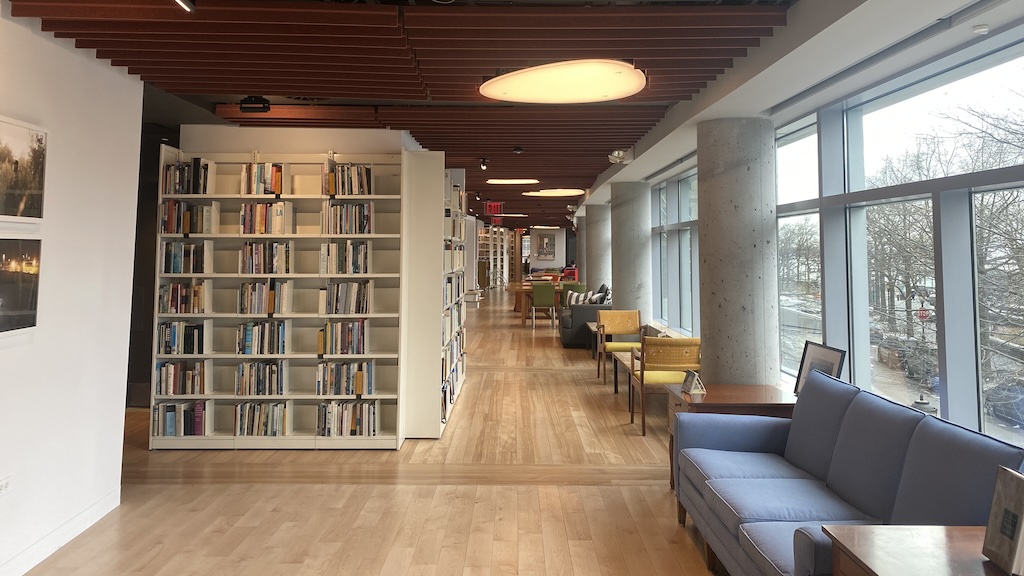A Walkable Guide on Public Art

The walkable square mile south of Chambers Street is, in fact, a grand, open-air museum, with dozens of permanent and temporary installations of large-scale sculpture and public art.
You might not immediately think of Lower Manhattan as an art lover’s paradise. But the walkable square mile south of Chambers Street is, in fact, a grand, open-air museum, with dozens of permanent and temporary installations of large-scale sculpture and public art. Dubuffet, Rosenthal and Noguchi are just a few of the famous artists whose masterpieces have found a home here.
Start your downtown art tour at the neighborhood’s northern edge. At 1 Police Plaza, across from City Hall, you’ll find “5-in-1” by Tony Rosenthal. Rosenthal’s work is a red Cor-Ten Steel mass standing a proud 35 feet tall. The five interlocking discs represent the five boroughs coming together as one city.
Next, head south until you reach “Louise Nevelson Plaza.” Located in the triangle between Maiden Lane, William and Liberty Streets, the plaza features seven black sculptures by the eponymous artist. Nevelson worked in Manhattan for the span of her 60-plus year career as an artist and regarded the city as one giant sculpture. Shadows and Flags (1977-78) refers to all seven pieces bundled together as a singular abstract unit and alludes to the wafting flags, ceremonious spirals, and blooming trees that define the New York City landscape.
Jean Dubuffet‘s “Group of Four Trees” (1969-72) is located a block south from Shadows and Flags at 28 Liberty Street. The looping black and white panels stand out against the rigid lines of the landmark building behind it. The “four trees” are created by a series of intertwined irregular planes, which lean in different directions and are connected by thick black outlines. The piece is part of Dubuffet’s “L’Hourloupe” cycle — a bold, graphic style inspired by a doodle.
Sharing 28 Liberty Street with Group of Four Trees is “Sunken Garden” (1961-64) by Isamu Noguchi. Set one story below ground level, the garden is surrounded on all sides by floor-to-ceiling glass windows. In the winter, the garden is a dry circular expanse; in the summer, it is transformed into a giant water fountain. Sunken Garden is not the only Noguchi in Lower Manhattan — what can perhaps be considered his most well-known work is located just a few blocks away in front of 140 Broadway.
“Red Cube” (1968) is emblematic of Lower Manhattan and of Noguchi as an artist. The bright, red-painted steel structure is in high contrast to the buildings around it, its diagonal lines cutting through the intense vertical architecture of its surroundings.
Across from Red Cube, Mark di Suvero’s “Joie de Vivre” (1998) juts 70 feet into the air. The bright red Cor-Ten Steel unrestricted tetrahedrons of the sculpture command attention from all those who pass it. Originally installed near the Holland Tunnel rotary, Joie de Vivre was moved to Zuccotti Park in 2006 and was made famous during the notorious Occupy Wall Street protests.
The relocation of sculptures in Lower Manhattan is not uncommon. “Double Check” (1982) by John Seward Johnson II briefly joined Joie de Vivre in Zuccotti Park and is now residing on the Northwest corner of Broadway and Liberty Street. The sculpture was originally located near the World Trade Center in Liberty Park Plaza. Part of a public place zoning requirement, Double Check became famous after the attacks on September 11th, when photos of the debris-covered piece were widely circulated. The scars from that day remain on the sculpture.
Just south of Joie de Vivre and Double Check along Broadway, the “Charging Bull” (1989) by Arturo di Modica was originally installed in front of the New York Stock Exchange. The “Bull,” as the piece is commonly referred to, has become the iconic symbol of Wall Street’s optimism and a must-see New York City attraction.
Along the promenade in Robert F. Wagner Jr. Park, you’ll spot Jim Dine’s “Ape & Cat (at the Dance)” (1993). The romantic and whimsical bronze and wood work is part of a series of drawings and sculptures that follow an absorbing creature couple. The sculpture manages to convey a tender happiness despite the absence of any human characteristics.
A few blocks north at the intersection of the Hudson River Esplanade and Rector Place is R.M. Fischer’s “Rector Gate” (1989). The stainless steel, bronze and granite work towers 50 feet high. The influence of Russian Constructivism and Science Fiction are evident and command a triumphant and grandiose presence.
“The Upper Room” (1987) by Ned Smyth highlights the influence of an entirely different period. The colonnaded court sculpture refers to the stylized temples of ancient Egypt. Red concrete pillars define the space which encloses a table, chess board, stools, an altar-like arbor and a sculpted palm tree.
Continuing north along the waterfront, you’ll come across “The Real World” (1992) by Tom Otterness in Rockefeller Park. The compilation of small bronze works exudes a playful glee. Otterness’ signature cartoon figures portray animals, people, bankers, robbers, pilgrims and prey rubbing shoulders in their own enchanting, whimsical and entertaining society.
In the fall of 2021, Lower Manhattan was bestowed a new piece of grand public art: Silverstein Properties (the operator of the World Trade Center complex) installed Frank Stella’s abstract sculpture “Jasper’s Split Star” (2017) on the plaza in front of Seven World Trade Center (between West Broadway and Greenwich Street, south of Vesey Street).
South of the Trade Center site, you’ll find Fritz Koenig’s “The Sphere” in the elevated Liberty Park that overlooks the site. Created in 1971, The Sphere originally sat in the middle of Austin J. Tobin Plaza, a square that took up the space between the two Twin Towers. During the September 11th attacks, the sculpture was damaged but never destroyed. Remaining relatively intact, the piece underwent minor reconstruction and was moved first to the Hope Garden in Batter Park and then to its current home in Liberty Park.
Tags: must see downtown, public art and green spaces

